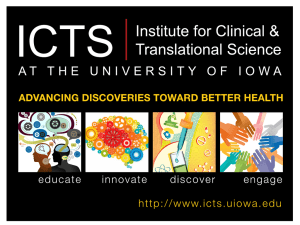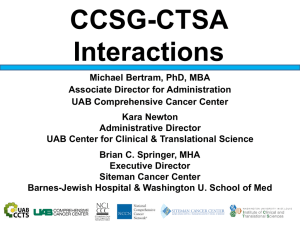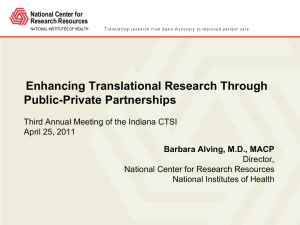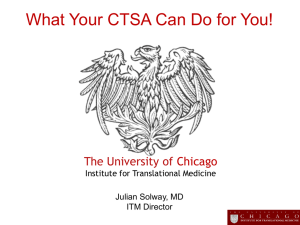Executive Committee 9-13 - Institute for Clinical and
advertisement
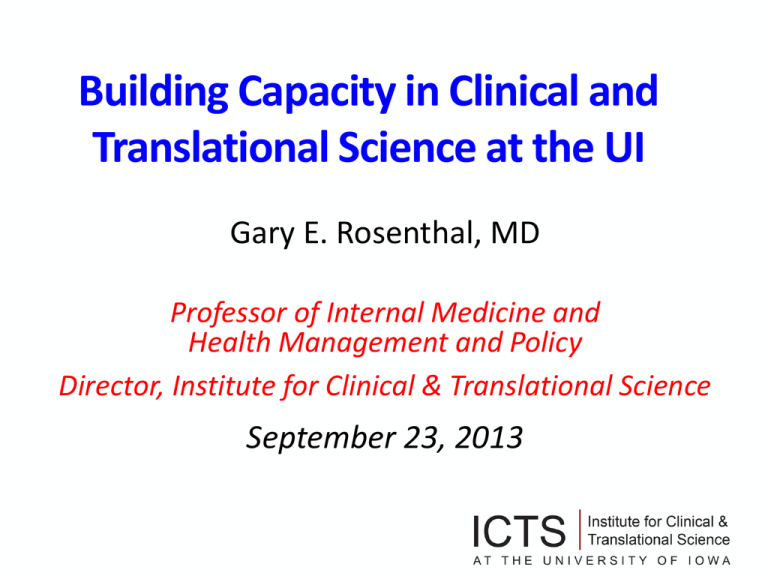
Building Capacity in Clinical and Translational Science at the UI Gary E. Rosenthal, MD Professor of Internal Medicine and Health Management and Policy Director, Institute for Clinical & Translational Science September 23, 2013 Overview of Presentation 1. National context for prioritizing developmental efforts in clinical and translational research (CTR) at the UI Recent IOM Report on CTSA Program Major concerns of NIH regarding clinical and translational research 2. ICTS priority areas over the coming 12-18 months 3. Key future issues for clinical and translational research at the UI IOM Report on CTSA Program: Major Recommendations 1. Strengthen NCATS Leadership of the CTSA Program Set measurable goals and objectives for the program that address the full spectrum of CTR Form strategic partnerships with NIH institutes and centers and with other research networks and industry 2. Reconfigure and streamline the efforts of the CTSA Consortium and establish a new multi-stakeholder Steering Committee that would provide direction IOM Report on CTSA Program: Major Recommendations (cont.) 3. Build on strengths of individual CTSAs in ways that: Drive innovation in methods across the spectrum of CTR Emphasize interdisciplinary team-based approaches to research Build partnerships with industry, other research networks, & community groups 4. Standardize evaluation processes for individual CTSAs and the CTSA Program as a whole that are built around clear, consistent, and innovative metrics and go beyond publications & number of grant awards IOM Report on CTSA Program: Major Recommendations (cont.) 5. Advance innovation in education & training Emphasize training models which focus on team science, leadership, community engagement, and entrepreneurship and which offer flexible and personalized training experiences across the CTR spectrum Utilize on line approaches that can be broadly disseminated 6. Ensure community engagement in all phases of CTR Ensure active community stakeholder participation in priority setting and decision making Define and clearly communicate goals and expectations for community engagement at individual CTSA programs IOM Report on CTSA Program: Major Recommendations (cont.) 7. Strengthen clinical and translational research relevant to child health identify and designate CTSAs with expertise in child health research as leaders in advancing clinical and translational research and as coordinators for CTSA program-wide efforts Promote and increase community engagement specific to child health by raising awareness of opportunities for children and families to participate in research & by involving patients and family members in identifying priorities and setting research agendas. Major Concerns of NIH About Clinical Research (Josephine Briggs, MD, CRF, 12/4/12) Studies cost too much Studies fail to recruit adequate numbers of patients to yield interpretable results Studies fail to start in a timely fashion Studies may not be asking the right questions or studying the right endpoints Major Concerns of NIH About Clinical Research Studies cost too much Studies fail to recruit adequate numbers of patients to yield interpretable results Studies fail to start in a timely fashion Studies may not be asking the right questions or studying the right endpoints Studies Cost Too Much Costs of conducting clinical trials are 60% of total drug development costs, compared to 30% in 1980s (Pfizer) High costs makes US less competitive worldwide Costs of conducting trials 1.5 to 3 times higher in the US than in India, China, Russia, or Brazil E.g., recently funded NHLBI ISCHEMIA Trial - Randomize 8000 patients with moderate angina on stress testing to cath & possible revasc or medical management with 4 year follow-up - Total cost $84 million $10,500 per subject Major Concerns of NIH About Clinical Research Studies cost too much Studies fail to recruit adequate numbers of patients to yield interpretable results Studies fail to start in a timely fashion Studies may not be asking the right questions or studying the right endpoints Failures to Recruit Adequate Numbers of Patients & Start in a Timely Fashion Overall, clinical trials enrollment rates dropped from 75% in 2000 of what was initially planned to 59% in 2006, while subject retention fell from 69% to 48%. 80% of trials are delayed at least one month because of unfulfilled enrollment. Industry perspective: For each day a drug is delayed from market, sponsors lose up to $8 M Clinical trials suffer from low MD participation with less than 4% of US MDs participating in trials and 3.5% relative decline annually since 2001 in the number of active investigators in the US Major Concerns of NIH About Clinical Research Studies cost too much Studies fail to recruit adequate numbers of patients to yield interpretable results Studies fail to start in a timely fashion Studies may not be asking the right questions or studying the right endpoints Studies May Not Ask the Right Questions or Study the Right Endpoints Many trials often use placebo as the comparator & don’t examine if new treatment better than existing treatments key question for clinical practice Orientation often around postulated biological mechanisms & measurement of intermediate outcomes less relevant to patients e.g., changes in blood markers or imaging results rather than health or symptoms Often enroll homogeneous patients with limited comorbidity to reduce response variation ICTS Priority Areas Over Next 1218 Months 1. Improve subject recruitment for clinical trials 2. Increase UI involvement in multi-site CTR consortia 3. Build capacity to conduct lower cost pragmatic trials 4. Develop functional research data warehouse incorporating Epic EMR & billing data 5. Promote drug discovery research & entrepreneurship 6. Work with IRB, Sponsored Programs & Compliance to improve research & contract approval process 7. Support “K to R” transition of junior investigators ICTS Priority Areas Over Next 1218 Months 1. Improve subject recruitment for clinical trials Capitalize on Epic provide investigators lists of eligible patients for trials & use BPAs to inform clinicians of patients’ eligibility at point of care Working with UI Marketing Office to more actively promote clinical trials new interactive website Relationships with Mercy Des Moines to enable recruitment of subjects in Des Moines for UI trials Increase recruitment statewide by participation in ResearchMarch national registry with transition to Iowa Heroes Research Registry ICTS Priority Areas Over Next 1218 Months (cont.) 2. Increase UI involvement in multi-site CTR consortia Increasing amount of funding for clinical research administered through U awards (i.e., contracts) Assist UI investigators in competing for opportunities to participate in clinical research networks (e.g. NINDS stroke & NHLBI ICU networks) Establish regional collaborations with other AMCs to facilitate recruitment & share best practices Promote unique UI resources (e.g., Animal Histology core, GMP drug facilities) ICTS Priority Areas Over Next 12-18 Months (cont.) 3. Build capacity to conduct lower cost pragmatic practice-based trials Funding obtained in 2012 from NIH Common Fund Healthcare Systems Collaboratory initiative Development of innovative approaches to facilitate pragmatic trials online platforms for informed consent & collecting patient reported outcomes data Create multi-institutional consortium to respond to new opportunities from PCORI for large pragmatic comparative effectiveness trials based on EMR data Develop model “learning clinic” ICTS Priority Areas Over Next 1218 Months (cont.) 4. Develop functional research data warehouse incorporating Epic EMR & GE/IDX billing data Working with HCIS on Park Street repository project Developing I2B2 warehouse to facilitate linkages with other institutions and create user friendly interface for investigators to conduct their own queries Will be critical to success of the CTSA grant and in responding to new RFAs from PCORI, AHRQ, and NIH on pragmatic trials ICTS Priority Areas Over Next 1218 Months (cont.) 5. Promote drug discovery research & entrepreneurship New pilot program that will support projects using the recently established HTS facility Recruitment of project manager (Kate Holt) with biotech start-up experience to help investigators move projects through developmental pipeline Collaborations with other CTSAs to fill gaps in expertise − Collaboration with KU CTSA – CDA for discovery mining and early phase drug repurposing trials − Participation in Stanford SPARK Program ICTS Priority Areas Over Next 1218 Months (cont.) 5. Promote drug discovery research & entrepreneurship Actively nurture collaborations with industry − Visiting professorships from leaders at Eli Lilly, Cook Medical, and other companies − Creation of external advisory board to help identify promising research and promote investigators New tracks in Translational Biomedicine MS program Promote changes in institutional culture such that investigators pursuing product development are recognized & rewarded ICTS Priority Areas Over Next 1218 Months (cont.) 6. Work with IRB, Sponsored Programs and Compliance Office to improve research and contract approval processes Increase UI involvement in shared and reciprocal IRB review processes for multi-site studies Promote adoption of standard contract language to improve approval turnaround times Ensure that UI interpretation of HIPAA and OHRP regulations is similar to peer institutions so as not to disadvantage UI investigators ICTS Priority Areas Over Next 1218 Months (cont.) 7. Increase efforts to support “K to R” transition of junior investigators through K Club (~50 NIH K, institutional K12, VA, and professional society career development awardees) Quarterly professional development seminars Semi-annual R01 workshops to guide trainees through the development of different components of grant Semi-annual mock study sections Key Future Institutional Issues in Clinical and Translational Science 1. Matching investigative capacity to emerging funding opportunities (e.g., CER, IPS cells) 2. Identifying institutional priorities for capacity building & targeting departmental recruiting around those areas 3. Building research informatics capacity (bio & medical) to respond to new Big Data opportunities 4. Increasing number of investigators who are national leaders in clinical trials research and leading trials 5. Conservative institutional attitudes towards risk that adversely impact IRB & contract approval processes

